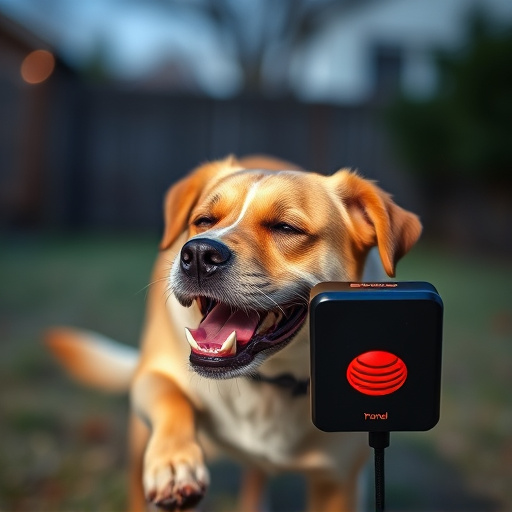Handheld sonic dog deterrents, emitting inaudible high-frequency sound waves, offer a non-violent approach to canine training for unwanted behaviors like barking. Their effectiveness varies by breed sensitivity, emphasizing responsible usage and tailored positive reinforcement techniques. Consistent, short training sessions with rewards and gradual intensity buildup maximize results while minimizing safety risks.
“Unleash a new approach to dog training with Handheld Sonic Dog Deterrents – an innovative solution for behavior management. This comprehensive guide delves into the world of ultrasonic repellents, exploring their effectiveness in addressing unwanted actions. We unravel the science behind these devices and provide practical tips for optimal results.
Learn how these compact tools emit high-frequency sound waves to deter dogs without harm, offering a safe and efficient training aid. Discover the key to successful integration into your dog’s training routine, ensuring positive outcomes.”
- Understanding Ultrasonic Repellents for Dogs
- How Handheld Sonic Dog Deterrents Work
- Evaluating Effectiveness and Safety
- Training Tips for Optimal Results with Sonic Repellents
Understanding Ultrasonic Repellents for Dogs
Ultrasonic repelents for dogs have gained popularity as a non-violent and effective training tool. These devices emit high-frequency sound waves that are inaudible to humans but can startle or deter canine behavior, such as barking or aggression. The handheld sonic dog deterrents work by targeting the dog’s hearing, which is more sensitive than human ears, without causing any physical harm.
While the effectiveness of ultrasonic repelents varies among dogs, many owners and professionals report positive results. Some breeds, however, may be less responsive due to their reduced hearing sensitivity or because they have become accustomed to such sounds in their environment. It’s important to note that these devices should always be used responsibly, ensuring they are a suitable solution for your dog’s specific needs, and as part of a comprehensive training program involving positive reinforcement techniques.
How Handheld Sonic Dog Deterrents Work
Handheld sonic dog deterrents are designed to address barking and other unwanted behaviors by emitting high-frequency sound waves that are inaudible to humans but disruptive to dogs. These devices work on the principle of creating an unpleasant sensation in a dog’s ears, causing them to stop the behavior that triggered the response. The effectiveness of handheld sonic dog deterrents lies in their ability to target specific dogs without affecting bystanders or causing harm. They are particularly useful in situations where traditional training methods have proven unsuccessful, such as when dealing with persistent barking or aggressive tendencies.
The sound waves emitted by these devices operate within a range that is above the human hearing threshold but within the sensitive range of canine hearing. When a dog exhibits unwanted behavior, the deterrent is activated, emitting the high-frequency sound. This sudden auditory stimulus disrupts the dog’s focus and can quickly stop persistent barking or aggressive displays. Over time, dogs learn to associate these sounds with negative consequences, modifying their behaviors accordingly. The effectiveness of handheld sonic dog deterrents has been well-documented, making them a valuable tool for responsible pet ownership and effective canine training.
Evaluating Effectiveness and Safety
When evaluating the effectiveness and safety of handheld sonic dog deterrents, it’s crucial to consider both their ability to disrupt unwanted canine behavior and their impact on the animal’s well-being. Studies have shown that these devices emit high-frequency sound waves that can effectively startle dogs, preventing them from barking or approaching certain areas. However, it’s important to note that not all dogs respond in the same manner; smaller breeds might be more sensitive to the sounds, while larger ones may require higher decibel levels for deterrence.
The safety of handheld sonic dog deterrents is another critical aspect. These devices are generally considered safe when used correctly, but they should never be aimed at a dog’s face or ears due to potential hearing damage. Users must follow the manufacturer’s guidelines and ensure the device is set to a safe volume level. Additionally, keeping the deterrent out of reach of children and other pets can prevent accidental misuse or injury.
Training Tips for Optimal Results with Sonic Repellents
When using handheld sonic dog deterrents, consistency is key to achieving optimal results. Schedule regular training sessions in short bursts, focusing on specific behaviors or areas where your dog needs improvement. Start by introducing the device as a positive reinforcement tool, rewarding good behavior with treats and praise when your dog remains calm in its presence. Gradually increase the intensity of the sonic signal over time, pairing it with a command like “leave it” or “stay,” allowing your dog to associate the sound with the action you’re trying to teach.
During training, maintain a safe distance from your dog and use the deterrent only when necessary. Avoid using it as a punishment, as this can create fear or aggression. Be patient and remember that every dog learns at their own pace. Regular, positive reinforcement sessions will help increase the effectiveness of the handheld sonic dog deterrent, leading to better behavior and a happier, more obedient pet.
Ultrasonic repellents, specifically handheld sonic dog deterrents, offer a safe and effective solution for managing canine behavior. By understanding how these devices work and employing proper training techniques, owners can achieve optimal results in addressing unwanted actions like barking or aggression. While not a cure-all, the right use of handheld sonic dog deterrents can significantly improve the quality of life for both dogs and their owners, fostering a calmer and more harmonious environment.
